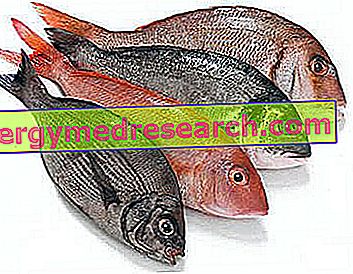Watch the video
X Watch the video on youtubeDefinition
"Pesce magro" is the name of a food category of animal origin; these are foods widely used in slimming diets and those useful for improving metabolic disorders, such as obesity and type 2 diabetes mellitus.

Compared to fatty fish, the lean one boasts a lower lipid content, although (from a qualitative point of view) it is not said that this characteristic makes it better or preferable to the other; everything depends on the food context where it is inserted.
What makes lean fish stand out?
The lean fish has all the chemical-nutritional requirements of foods with "lean proteins", that is all those foods that contain:
- A high protein content
- A reduced lipid intake
NB . The term lean proteins is a semantic distortion, as the foods and not the plastic molecules that characterize them are thin.
Defining exactly the fish fatness level is not easy; it is possible to recognize different classifications, but the most used are two:
- Lean fish and fatty fish
- Lean fish, lean fish, half-fat fish and fatty fish.
Depending on the type of classification, the same food could fall into two different categories; however, the most useful and practical requirement in assessing the fat content of the fish is that of 10 grams (g) per edible edible portion. In other words, any fish product with a lower lipid composition or at most equal to 10g per 100g of raw product can be defined as "lean fish" .
NB . In general, the nutritional translation of the " food composition tables" excludes the integumentary component of the animal (ie the "skin") which, on the other hand, almost always brings a good fat content. To be clear, eating a fish with skin means introducing a higher lipid percentage than the same clean food.
Leaner fish and fishery products
| Food | Proteins (g) | Lipids (g) | Cholesterol (mg) |
| Anchovies | 16.8 | 2.6 | 61.0 |
| Lobster | 16.0 | 1.9 | 70.0 |
| Squid | 12.6 | 1.7 | 64.0 |
| Grouper | 17.0 | 2.0 | - |
| Corvina | 20.0 | 0.8 | 75.0 |
| Cozza | 11.7 | 2.7 | 121 |
| Crayfish | 13.6 | 0.6 | 150 |
| Canned crab | 18.1 | 0.9 | 101 |
| Pike | 18.7 | 0.6 | - |
| Cod | 17.0 | 0.3 | 50.0 |
| Pier | 17.4 | 0.3 | 52.0 |
| murmurs | 18.0 | 1.9 | 45.0 |
| Oyster | 10.2 | 0.9 | 150 |
| Pagello | 21.0 | 1.9 | 35.0 |
| Palombo | 16.0 | 1.2 | - |
| Octopus | 10.6 | 1.0 | 72.0 |
| Race | 14.2 | 0.9 | - |
| Rhombus | 16.3 | 1.3 | - |
| Sheepshead | - | 1.2 | 65.0 |
| Redfish | 19.0 | 0.4 | 67.0 |
| Sepia | 14.0 | 1.5 | 64.0 |
| Sole | 16.9 | 1.4 | 25.0 |
| Sea bass | 16.5 | 1.5 | 48.0 |
| Clam | 10.2 | 2.5 | - |
Lean fish: is it right to prefer it?
Lean fish is widely used in low-calorie diets as it provides a good amount of protein and a reduced portion of fat; in reality, this concept is not always correct. Considering ONLY the fish proper (those pinnuti) this statement is sufficiently reliable; on the contrary, considering also lamellibranch (bivalve) molluscs and crustaceans, it is possible to distinguish numerous foods which, although containing few triglycerides, show a significant intake of cholesterol (highlighted in red in the table above).
At the same time it is also worth mentioning the quality of the fatty acids contained in fishery products; this varies significantly between species ... but also regarding the origin of the product! A fish caught (compared to a fish bred and fed with animal meal based pellets) contains less MA triglycerides with more GOOD fatty acids, or essential polyunsaturated (essential fatty acids - AGE). Specifically, the AGEs present in fish (especially blue and cod) belong to the ω3 family and boast numerous chemical and metabolic characteristics useful for:
- Prevent and treat dyslipidemia
- Prevent and treat high blood pressure
... in addition to performing numerous useful metabolic functions such as the precursion of ANTI-inflammatory molecules and the plastic composition of the "liquid mosaic" on cell membranes.
This means that, although lean fish can boast less fat, all semi-fat or fatty fish containing ω3 must NOT be excluded from the diet; thanks to the increased lipid content of AGE, they can be particularly useful for achieving the minimum recommended rations (ω3 = 0.5% of the total daily kcal, equal to about 8-16 g / day respectively in diets of 1500 and 3000 KCal) and in the treatment of certain metabolic disorders such as hypertension, dyslipidemia and even type 2 diabetes mellitus.



